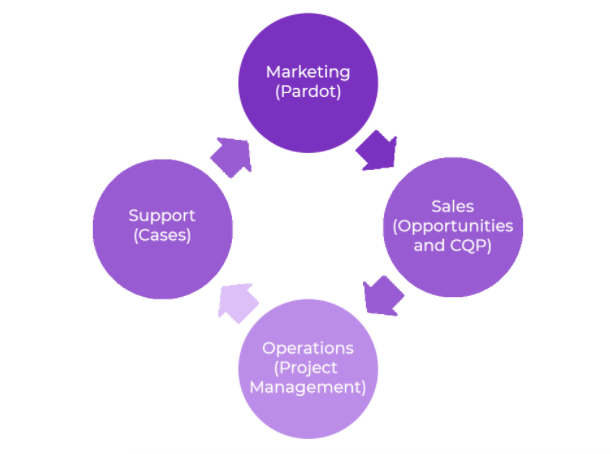By: Jaime Brown
Salesforce can be very misleading for people who are not familiar. Many assume that because Sales is in the name, the tool must only be for salespeople. In reality, the most successful companies leverage Salesforce across all departments within the company such as Marketing, Sales, Operations and Customer Support. By bringing each department on to the platform, it helps close gaps and avoids siloed systems. In today’s blog, I will focus specifically on how an Operations team can effectively leverage Salesforce with the help of TaskRay to run projects.

How can Operations use Salesforce?
- Project Management/Tracking Implementations! When Sales closes an Opportunity in Salesforce, the Operations team is notified about the new upcoming project and the important details for planning ahead. This makes for a smooth transition for the client from Prospect to Customer when working with a new department. Our operations team leverages TaskRay to track our projects for our clients. With TaskRay we are able to track the granular tasks that make up each project from start to finish. Managing a Project becomes much easier for our Project Managers so they can see all the details related to the project in one central location.
Resource Planning & Utilization:
- Prior to an Opportunity closing in Salesforce, we are able to leverage Resource Planning to plan appropriately for potential projects. We can see which resources have availability and what skills they specialize in to make sure the team is not overwhelmed and can be managed appropriately. Within the Resource Planning, resources have assigned calendars which will automatically plan ahead if they have an upcoming holiday or paid time off scheduled. This allows for resources on a project team to collaborate and work together to ensure the project moves forward even when a teammate is out of the office.
Project Tasks:
- Each project is made up of several project tasks. The individual task can have dependencies to show which tasks should be completed in which order. We also leverage an estimated completion date on each task so the project team knows which tasks need to be completed first for a demonstration.Each individual task can have its own status to track the progress and as they are completed, the project completion status moves closer to completion.
Reporting:
- If you didn’t already know, as long as the data is in Salesforce it is all reportable. This helps for future planning for Sales and Operations. We are able to see if we are completing projects on time and how many resources are needed based on the size of the project.
When the Operations team leverages a tool such as TaskRay on the Salesforce platform there is more organization which in turn sets us up for success. We are able to keep all client communication in one location so everyone is clear on where the project is at. It doesn’t matter if a person in the Sales department wants to see the project progress or someone in Support needs to see what was implemented to help support a Case.The departments are connected, allowing for better workflows and overall success for our clients.
If you know other departments in your company utilizing Salesforce but your department isn’t, or vise versa, think about how much easier it would be if everyone was communicating on one system!
